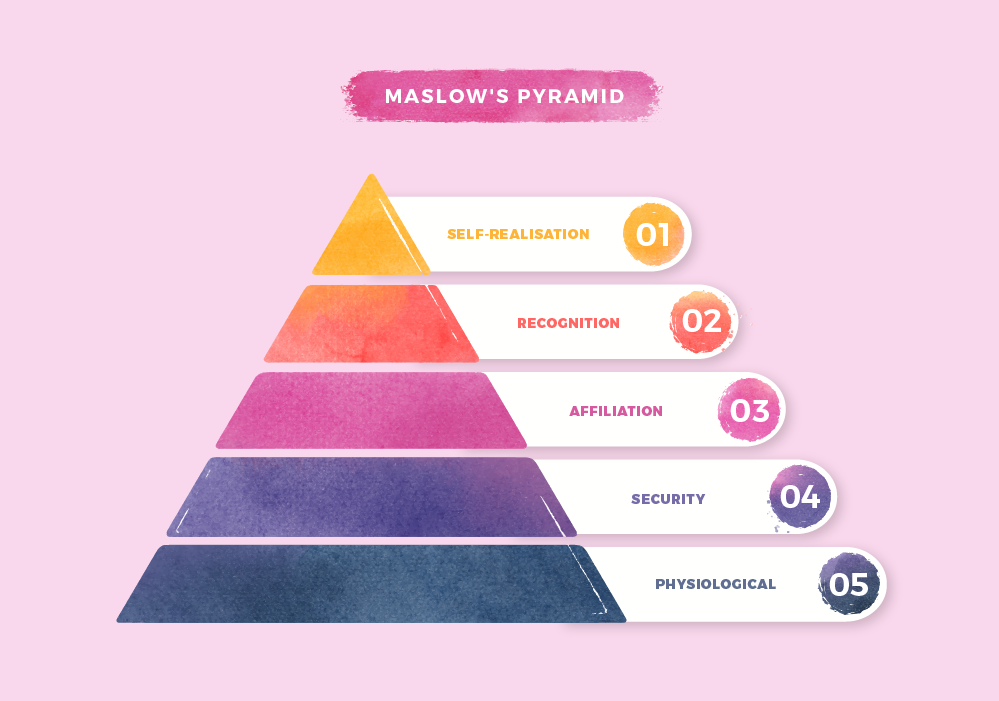Our motivations, both those that have to do with personal issues and professional development, are divided into levels. But in order to desire high goals, there are certain vital needs that we should first have covered.
When, for example, we enjoy a safe working environment where we feel confident, we can aspire to more ambitious goals such as professional recognition or self-fulfilment. This is precisely what Abraham Maslow talks about in his theory of motivation. Let’s see how we can apply Maslow’s Pyramid in the workplace.
What will I read about in this article?
What is Maslow’s Pyramid?
Imagine a pyramid divided into five levels. Each of these levels represents a set of human needs: physiological, security, love and attachment, self-esteem and self-fulfilment.
This visual structure is at the heart of the theory developed by the American psychologist Abraham Maslow in 1943. According to Maslow, in order to move towards personal and professional development, a person must satisfy each level of needs, starting from the bottom and working up to the top. In other words, we cannot achieve self-fulfilment without having achieved all of the above, starting with physiological needs.
The 5 Levels of Maslow’s Pyramid
This theory suggests that human needs are organised in a hierarchy of ascending importance and complexity, from the most basic to the highest or most sophisticated:
* Physiological: These are the basic needs for survival, such as food, rest and shelter.
* Security: People seek safety and security. This includes physical safety, financial stability, job security and health.
* Affiliation: Refers to social relationships and the need for love, friendship, affection and belonging to a group, such as a family or a community.
* Recognition: It’s the desire for esteem, both for oneself and for the recognition of others, achieving success and respect.
* Self-realisation: At the top of the pyramid are self-fulfilment needs. This may include personal development, creativity, problem solving and the pursuit of meaningful personal goals.
The pyramid in the workplace
How is Maslow’s Pyramid reflected in the world of work? This theory can be a powerful tool for fostering an organisational culture that takes into account the needs and motivations of individuals so that they can reach their full potential and cover as much as possible all levels of the pyramid up to the top.
For example, meeting physiological needs in the work context can translate into offering services to employees that facilitate their well-being and help them integrate their work and professional lives in a more natural way. Providing a canteen with healthy menus, health assistance or a shuttle service to the company can help employees meet their most basic living needs.
Furthermore, in the workplace, security is not only about a safe physical environment, free from risks and threats, but also about providing open, flexible and comfortable working spaces.

This may include well-equipped work areas that promote creativity, accessibility and collaboration.
Promoting a positive and collaborative work environment is vital for employees to feel part of a team and valued for their contribution to shared goals. Good interpersonal relationships with colleagues and superiors not only improve the quality of working life, but also increase motivation and commitment to the organisation. In this article we take a closer look at this topic.
The importance of recognition at work leads us to consider how it influences people’s motivation and continuous effort. Feeling valued for performance not only encourages innovation and overcoming limits, but also strengthens the sense of belonging and commitment to the organisation.
“Feeling valued for performance not only drives innovation and overcoming limits, but also strengthens the sense of belonging and commitment to the organisation”.
At the top of the pyramid is self-fulfilment. This level represents the ultimate professional and personal goal, where people apply their skills to the fullest, feel completely realised and work with a purpose that transcends mere survival or social recognition. However, according to Maslow, reaching this state of fulfilment and self-fulfilment is almost impossible if the previous needs are not satisfied.
Reflecting on how each of these levels impacts on working lives can help companies create more humane and productive environments, where every employee has the opportunity to develop.
Advantages of applying Maslow at work
Following Maslow’s pyramid theory in the workplace has significant benefits for organisations and the people within them. It increases employee satisfaction and motivation, which in turn improves productivity and reduces staff turnover. An employee whose basic needs are met and who works in an environment that promotes personal growth is a committed employee who identifies with what he or she does.
Organisations that understand and apply Maslow’s pyramid are better equipped to create human resource management strategies that not only seek business success, but also the well-being and development of their employees. In a rapidly evolving world of work, getting back to the basics of human motivation can be the key to unlocking extraordinary potential.
Maslow’s Pyramid reminds us that, in the end, companies are not just economic entities, but communities of people with wants, needs and desires. Addressing these human dimensions can make the difference between a good organisation and an exceptional one.
Sources:


